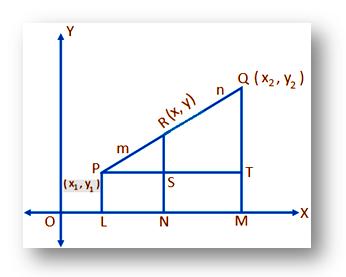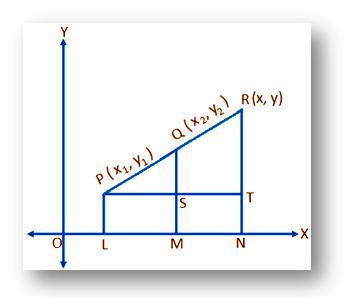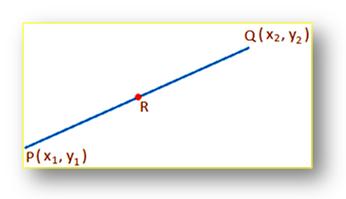Subscribe to our ▶️ YouTube channel 🔴 for the latest videos, updates, and tips.
Division of Line Segment
Here we will discuss about internal and external division of line segment.
To find the co-ordinates of the point dividing the line segment joining two given points in a given ratio:
(i) Internal Division of line segment:
Let (x₁, y₁) and (x₂, y₂) be the cartesian co-ordinates of the points P and Q respectively referred to rectangular co-ordinate axes OX and OY and the point R divides the line-segment PQ internally in a given ratio m : n (say), i.e., PR : RQ = m : n. We are to find the co-ordinates of R.
Let, (x, y) be the required co-ordinate of R . From P, Q and R, draw PL, QM and RN perpendiculars on OX. Again, draw PT parallel to OX to cut RN at S and QM at T.
Then,
PS = LN = ON - OL = x – x₁;
PT = LM = OM – OL = x₂ - x₁;
RS = RN – SN = RN – PL = y - y₁;
and QT = QM – TM = QM – PL = y₂ – y₁
Again, PR/RQ = m/n
or, RQ/PR = n/m
or, RQ/PR + 1 = n/m + 1
or, (RQ + PR/PR) = (m + n)/m
o, PQ/PR = (m + n)/m
Now, by construction, the triangles PRS and PQT are similar; hence,
PS/PT = RS/QT = PR/PQ
Taking, PS/PT = PR/PQ we get,
(x - x₁)/(x₂ - x₁) = m/(m + n)
or, x (m + n) – x₁ (m + n) = mx₂ – mx₁
or, x ( m + n) = mx₂ - mx₁ + m x₁ + nx₁ = mx₂ + nx₁
Therefore, x = (mx2 + nx1)/(m + n)
Again, taking RS/QT = PR/PQ we get,
(y - y₁)/(y₂ - y₁) = m/(m + n)
or, ( m + n) y - ( m + n) y₁ = my₂ – my₁
or, ( m+ n)y = my₂ – my₁ + my₁ + ny₁ = my₂ + ny₁
Therefore, y = (my₂ + ny₁)/(m + n)
Therefore, the required co-ordinates of the point R are
((mx₂ + nx₁)/(m + n), (my₂ + ny₁)/(m + n))
(ii) External Division of line segment:
Let (x₁, y₁) and (x₂, y₂) be the cartesian co-ordinates of the points P and Q respectively referred to rectangular co-ordinate axes OX and OY and the point R divides the line-segment PQ externally in a given ratio m : n (say) i.e., PR : RQ = m : n. We are to find the co-ordinates of R.
Let, (x, y) be the required co-ordinates of R. Draw PL, QM and RN perpendiculars on OX. Again, draw PT parallel to OX to cut RN at S and QM and RN at S and T respectively, Then,
PS = LM = OM - OL = x₂ – x₁;
PT = LN = ON – OL = x – x₁;
QT = QM – SM = QM – PL = y₂ – y₁
and RT = RN – TN = RN – PL = y — y₁
Again, PR/RQ = m/n
or, QR/PR = n/m
or, 1 - QR/PR = 1 - n/m
or, PR - RQ/PR = (m - n)/m
or, PQ/PR = (m - n)/m
Now, by construction, the triangles PQS and PRT are similar; hence,
PS/PT = QS/RT = PQ/PR
Taking, PS/PT = PQ/PR we get,
(x₂ - x₁)/(x - x₁) = (m - n)/m
or, (m – n)x - x₁(m – n) = m (x₂ - x₁)
or, (m - n)x = mx₂ – mx₁ + mx₁ - nx₁ = mx₂ - nx₁.
Therefore, x = (mx₂ - nx₁)/(m - n)
Again, taking QS/RT = PQ/PR we get,
(y₂ - y₁)/(y - y₁) = (m - n)/m
or, (m – n)y - (m – n)y₁ = m(y₂ - y₁)
or, (m - n)y = my₂ – my₁ + my₁ - ny₁ = my₂ - ny₁
Therefore, x = (my₂ - ny₁)/(m - n)
Therefore, the co-ordinates of the point R are
((mx₂ - nx₁)/(m - n), (my₂ - ny₁)/(m - n))
Corollary: To find the co-ordinates of the middle point of a given line segment:
Let (x₁, y₁) and (x₂, y₂) he the co-ordinates of the points P and Q respectively and R, the mid-point of the line segment PQ. To find the co-ordinates R. Clearly, the point R divides the line segment PQ internally in the ratio 1 : 1; hence, the co-ordinates of R are ((x₁ + x₂)/2, (y₁ + y₂)/2). [Putting m = n the co-ordinates or R of ((mx₂ + nx₁)/(m + n), (my₂ + ny₁)/(m + n))]. This formula is also known as midpoint formula. By using this formula we can easily find the midpoint between the two co-ordinates.
Example on Division of Line Segment:
1. A diameter of a circle has the extreme points (7, 9) and (-1, -3). What would be the co-ordinates of the centre?
Solution:
Clearly, the mid-point of the given diameter is the centre of the circle. Therefore, the required co-ordinates of the centre of the circle = the co-ordinates of the mid-point of the line-segment joining the points (7, 9) and (- 1, - 3)
= ((7 - 1)/2, (9 - 3)/2) = (3, 3).
2. A point divides internally the line- segment joining the points (8, 9) and (-7, 4) in the ratio 2 : 3. Find the co-ordinates of the point.
Solution:
Let (x, y) be the co-ordinates of the point which divides internally the line-segment joining the given points. Then,
x = (2 ∙ (- 7) + 3 ∙ 8)/(2 + 3) = (-14 + 24)/5 = 10/5 = 2
And y = (2 ∙ 4 + 3 ∙ 9)/(2 + 3) = (8 + 27)/5 = 35/5 = 5
Therefore, the co-ordinates of the required point are (2, 7).
[Note: To get the co-ordinates of the point in question we have used formula,
x = (mx₁ + n x₁)/(m + n) and y = my₂ + ny₁)/(m + n).
For the given problem, x₁ = 8, y₁ = 9, x₂ = -7, y₂ = 4, m = 2 and n = 3.]
3. A (4, 5) and B (7, - 1) are two given points and the point C divides the line-segment
AB externally in the ratio 4 : 3. Find the co-ordinates of C.
Solution:
Let (x, y) be the required co-ordinates of C. Since C divides the line-segment AB externally in the ratio 4 : 3 hence,
x = (4 ∙ 7 - 3 ∙ 4)/(4 - 3) = (28 - 12)/1 = 16
And y = (4 ∙ (-1) - 3 ∙ 5)/(4 - 3) = (-4 - 15)/1 = -19
Therefore, the required co-ordinates of C are (16, - 19).
[Note: To get the co-ordinate of C we have used formula,
x = (mx₁ + n x₁)/(m + n) and y = my₂ + ny₁)/(m + n).
In the given problem, x₁ = 4, y₁ = 5, x₂ = 7, y₂ = - 1, m = 4 and n = 3].
4. Find the ratio in which the line-segment joining the points (5, - 4) and (2, 3) is divided by the x-axis.
Solution:
Let the given points be A (5, - 4) and B (2, 3) and x-axis. intersects the line-segment ¯(AB )at P such that AP : PB = m : n. Then the co-ordinates of P are ((m ∙ 2 + n ∙ 5)/(m + n), (m ∙ 3 + n ∙ (-4))/(m + n)). Clearly, the point P lies on the x-axis ; hence, y co-ordinate of P must be zero.
Therefore, (m ∙ 3 + n ∙ (-4))/(m + n) = 0
or, 3m - 4n = 0
or, 3m = 4n
or, m/n = 4/3
Therefore, the x-axis divides the line-segment joining the given points internally in 4 : 3.
5. Find the ratio in which the point (- 11, 16) divides the '-line segment joining the points (- 1, 2) and (4, - 5).
Solution:
Let the given points be A (- 1, 2) and B (4, - 5) and the line-segment AB is divided in the ratio m : n at (- 11, 16). Then we must have,
-11 = (m ∙ 4 + n ∙ (-1))/(m + n)
or, -11m - 11n = 4m - n
or, -15m = 10n
or, m/n = 10/-15 = - 2/3
Therefore, the point (- 11, 16) divides the line-segment ¯BA externally in the ratio 3 : 2.
[Note: (i) A point divides a given line-segment internally or externally in a definite ratio according as the value of m:n is positive or negative.
(ii) See that we can obtain the same ratio m : n = - 2 : 3 using the condition 16 = (m ∙ (-5) +n ∙ 2)/(m + n)]
● Co-ordinate Geometry
- What is Co-ordinate Geometry?
- Rectangular Cartesian Co-ordinates
- Polar Co-ordinates
- Relation between Cartesian and Polar Co-Ordinates
- Distance between Two given Points
- Distance between Two Points in Polar Co-ordinates
- Division of Line Segment: Internal & External
- Area of the Triangle Formed by Three co-ordinate Points
- Condition of Collinearity of Three Points
- Medians of a Triangle are Concurrent
- Apollonius' Theorem
- Quadrilateral form a Parallelogram
- Problems on Distance Between Two Points
- Area of a Triangle Given 3 Points
- Worksheet on Quadrants
- Worksheet on Rectangular – Polar Conversion
- Worksheet on Line-Segment Joining the Points
- Worksheet on Distance Between Two Points
- Worksheet on Distance Between the Polar Co-ordinates
- Worksheet on Finding Mid-Point
- Worksheet on Division of Line-Segment
- Worksheet on Centroid of a Triangle
- Worksheet on Area of Co-ordinate Triangle
- Worksheet on Collinear Triangle
- Worksheet on Area of Polygon
- Worksheet on Cartesian Triangle
11 and 12 Grade Math
From Division of Line Segment to HOME PAGE
Didn't find what you were looking for? Or want to know more information about Math Only Math. Use this Google Search to find what you need.





New! Comments
Have your say about what you just read! Leave me a comment in the box below. Ask a Question or Answer a Question.